Effect of Deep Vertical Rotary Tillage on Soil Properties and Sugarcane Biomass in Rainfed Dry-Land Regions of Southern China
Abstract
1. Introduction
2. Materials and Methods
2.1. Site Description
2.2. Experimental Design
2.3. Sampling and Measurements
2.3.1. Soil Water Storage
2.3.2. Other Soil Properties
2.3.3. Vegetation Characteristics
2.3.4. Meteorological Factors
2.3.5. Increase Rate
2.4. Statistical Analysis
3. Results
3.1. Soil Bulk Density and Soil Porosity
3.2. Soil Water Storage
3.3. Sugarcane Characteristics
4. Discussion
5. Conclusions
- (1)
- DVRT favored soil bulk density and soil porosity especially in deep soil, resulting in an improved soil environment for root growth and increased sugarcane biomass.
- (2)
- DVRT increased soil water storage to some extent (p > 0.05) compared with CT, which can be attributed to the combined effects of increased soil water holding capacity and increased vegetation water consumption under DVRT.
- (3)
- DVRT significantly (p < 0.05) increased the final aboveground biomass, underground biomass, and plant height compared to CT except for the final root length. The final increase rate of DVRT in aboveground biomass ranged from 50.14% to 68.90% compared to CT.
- (4)
- The differences in soil properties and sugarcane characteristics were not significantly different between DVRT with different growth years when considering the entire sampling period, indicating that the effect of DVRT can last for at least two years.
Author Contributions
Funding
Conflicts of Interest
References
- Aguilar-Rivera, N.; Rodríguez, L.D.A.; Enríquez, R.V.; Castillo, M.A.; Herrera, S.A. The Mexican sugarcane industry: Overview, constraints, current status and long-term trends. Sugar Tech 2012, 14, 207–222. [Google Scholar] [CrossRef]
- Li, Y.R.; Yang, L.T. Sugarcane agriculture and sugar industry in China. Sugar Tech 2015, 17, 1–8. [Google Scholar] [CrossRef]
- Lin, L.; Li, Z.Y.; Hu, C.J.; Zhang, X.C.; Chang, S.P.; Yang, L.T.; Li, Y.R.; An, Q.L. Plant growth-promoting nitrogen-fixing enterobacteria are in association with sugarcane plants growing in Guangxi, China. Microbes Environ. 2012, 27, 391–398. [Google Scholar] [CrossRef]
- Ou, Y.G.; Malcolm, W.; Yang, D.T.; Liu, Q.T.; Zheng, D.K.; Wang, M.M.; Liu, H.C. Mechanization technology: The key to sugarcane production in China. Int. J. Agric. Biol. Eng. 2013, 6, 1–27. [Google Scholar]
- Li, Y.R.; Wei, Y.A. Sugar industry in China: R & D and policy initiatives to meet sugar and biofuel demand of future. Sugar Tech 2006, 8, 203–216. [Google Scholar]
- Sun, B.F.; Zhao, H.; Lv, Y.Z.; Lu, F.; Wang, X.K. The effects of nitrogen fertilizer application on methane and nitrous oxide emission/uptake in Chinese croplands. J. Integr. Agric. 2016, 15, 440–450. [Google Scholar] [CrossRef]
- Zhai, L.C.; Xu, P.; Zhang, Z.B.; Wei, B.H.; Jia, X.L.; Zhang, L.H. Improvements in grain yield and nitrogen use efficiency of summer maize by optimizing tillage practice and nitrogen application rate. Agron. J. 2019, 111, 666–676. [Google Scholar] [CrossRef]
- Lampurlanés, J.; Angás, P.; Cantero-Martınez, C. Tillage effects on water storage during fallow, and on barley root growth and yield in two contrasting soils of the semi-arid Segarra region in Spain. Soil Tillage Res. 2002, 65, 207–220. [Google Scholar] [CrossRef]
- Gathala, M.; Timsina, J.; Islam, S.; Rahman, M.; Hossain, I.; Ar-Rashid, H.; Ghosh, A.; Govaerts, B.; Mezzalama, M.; Sayre, K.D.; et al. Long-term consequences of tillage, residue management, and crop rotation on maize/wheat root rot and nematode populations in subtropical highlands. Appl. Soil Ecol. 2006, 32, 305–315. [Google Scholar]
- Obalum, S.E.; Obi, M.E. Physical properties of a sandy loam Ultisol as affected by tillage-mulch management practices and cropping systems. Soil Tillage Res. 2010, 108, 30–36. [Google Scholar] [CrossRef]
- Castellini, M.; Ventrella, D. Impact of conventional and minimum tillage on soil hydraulic conductivity in typical cropping system in Southern Italy. Soil Tillage Res. 2012, 124, 47–56. [Google Scholar] [CrossRef]
- Oyedele, D.J.; Schjonning, P.; Sibbesen, E.; Debosz, K. Aggregation and organic matter fractions of three Nigerian soils as affected by soil disturbance and incorporation of plant material. Soil Tillage Res. 1999, 50, 105–114. [Google Scholar] [CrossRef]
- Zhang, G.S.; Chan, K.Y.; Oates, A.; Heenan, D.P.; Huang, G.B. Relationship between soil structure and runoff/soil loss after 24 years of conservation tillage. Soil Tillage Res. 2007, 92, 122–128. [Google Scholar] [CrossRef]
- García-Marco, S.; Abalos, D.; Espejo, R.; Vallejo, A.; Mariscal-Sancho, I. No tillage and liming reduce greenhouse gas emissions from poorly drained agricultural soils in Mediterranean regions. Sci. Total Environ. 2016, 566–567, 512–520. [Google Scholar] [CrossRef]
- Badagliacca, G.; Benítez, E.; Amato, G.; Badalucco, L.; Giambalvo, D.; Laudicina, V.A.; Ruisi, P. Long-term no-tillage application increases soil organic carbon, nitrous oxide emissions and faba bean (Vicia faba L.) yields under rain-fed Mediterranean conditions. Sci. Total Environ. 2018, 639, 350–359. [Google Scholar] [CrossRef]
- Gal, A.; Vyn, T.J.; Micheli, E.; Kladivko, E.J.; McFee, W.W. Soil carbon and nitrogen accumulation with long-term no-till versus moldboard plowing overestimated with tilled-zone sampling depths. Soil Tillage Res. 2007, 96, 42–51. [Google Scholar] [CrossRef]
- Thomas, G.A.; Dalal, R.C.; Standley, J. No-till effects on organic matter, pH, cation exchange capacity and nutrient distribution in a Luvisol in the semi-arid subtropics. Soil Tillage Res. 2007, 94, 295–304. [Google Scholar] [CrossRef]
- Václav, S.; Radek, V.; Jana, C.; Helena, K.; Pavel, R. Winter wheat yield and quality related to tillage practice: Input level and environmental conditions. Soil Tillage Res. 2013, 132, 77–85. [Google Scholar]
- Zhai, L.C.; Xu, P.; Zhang, Z.B.; Li, S.K.; Xie, R.Z.; Zhai, L.F.; Wei, B.H. Effects of deep vertical rotary tillage on dry matter accumulation and grain yield of summer maize in the Huang-Huai-Hai Plain of China. Soil Tillage Res. 2017, 170, 167–174. [Google Scholar] [CrossRef]
- Cassel, D.K. Tillage effects on corn production and soil physical conditions. Soil Sci. Soc. Am. J. 1995, 59, 1436–1443. [Google Scholar] [CrossRef]
- Hou, X.Q.; Li, R.; Jia, Z.K.; Han, Q.F.; Wang, W.; Yang, B.P. Effects of rotational tillage practices on soil properties, winter wheat yields and water-use efficiency in semi-arid areas of north-west China. Field Crops Res. 2012, 129, 7–13. [Google Scholar] [CrossRef]
- Nawaz, M.F.; Bourrié, G.; Trolard, F. Soil compaction impact and modelling: A review. Agron. Sustain. Dev. 2012, 33, 291–309. [Google Scholar] [CrossRef]
- Khorami, S.S.; Kazemeini, S.A.; Afzalinia, S.; Gathala, M.K. Changes in soil properties and productivity under different tillage practices and wheat genotypes: A short-term study in Iran. Sustainability 2018, 10, 3273. [Google Scholar] [CrossRef]
- Cai, H.G.; Ma, W.; Zhang, X.Z.; Ping, J.Q.; Yan, X.G.; Liu, J.Z.; Yuan, J.C.; Wang, L.C.; Ren, J. Effect of subsoil tillage depth on nutrient accumulation, root distribution, and grain yield in spring maize. Crop J. 2014, 2, 297–307. [Google Scholar] [CrossRef]
- Piao, L.; Qi, H.; Li, C.F.; Zhao, M. Optimized tillage practices and row spacing to improve grain yield and matter transport efficiency in intensive spring maize. Field Crops Res. 2016, 198, 258–268. [Google Scholar] [CrossRef]
- Lampurlanés, J.; Angás, P.; Cantero-Martınez, C. Root growth, soil water content and yield of barley under different tillage systems on two soils in semiarid conditions. Field Crops Res. 2001, 69, 27–40. [Google Scholar] [CrossRef]
- Sisti, C.P.J.; dos Santos, H.P.; Kohhann, R.; Alves, B.J.R.; Urquiaga, S.; Boddey, R.M. Change in carbon and nitrogen stocks in soil under 13 years of conventional or zero tillage in southern Brazil. Soil Tillage Res. 2004, 76, 39–58. [Google Scholar] [CrossRef]
- Shao, Y.H.; Xie, Y.X.; Wang, C.Y.; Yue, J.Q.; Yao, Y.Q.; Li, X.D.; Liu, W.X.; Zhu, Y.J.; Guo, T.C. Effects of different soil conservation tillage approaches on soil nutrients, water use and wheat-maize yield in rainfed dry-land regions of North China. Eur. J. Agron. 2016, 81, 37–45. [Google Scholar] [CrossRef]
- Laddha, K.C.; Totawat, K.L. Effects of deep tillage under rainfed agriculture on production of sorghum (Sorghum biocolor L. Moench) intercropped with greengram (Vigna radiata L. Wilczek) in western India. Soil Tillage Res. 1997, 43, 241–250. [Google Scholar] [CrossRef]
- Hamza, M.A.; Anderson, W.K. Soil compaction in cropping systems: A review of the nature: Causes and possible solutions. Soil Tillage Res. 2005, 82, 121–145. [Google Scholar] [CrossRef]
- Jabro, J.D.; Stevens, W.B.; Evans, R.G.; Iversen, W.M. Tillage effects on physical properties in two soils of the Northern Great Plains. Appl. Eng. Agric. 2009, 25, 377–382. [Google Scholar] [CrossRef]
- Varsa, E.C.; Chong, S.K.; Abolaji, J.O.; Farquhar, D.A.; Olsen, F.J. Effect of deep tillage on soil physical characteristics and corn (Zea mays L.) root growth and production. Soil Tillage Res. 1997, 43, 219–228. [Google Scholar] [CrossRef]
- Sojka, R.E.; Home, D.J.; Ross, C.W.; Baker, C.J. Subsoiling and surface tillage effects on soil physical properties and forage oat stand and yield. Soil Tillage Res. 1997, 40, 125–144. [Google Scholar] [CrossRef]
- Busscher, W.J.; Frederick, J.R.; Bauer, P.J. Timing effects of deep tillage on penetration resistance and wheat and soybean yield. Soil Sci. Soc. Am. J. 2000, 64, 999–1003. [Google Scholar] [CrossRef]
- Kladivko, E.J. Tillage systems and soil ecology. Soil Tillage Res. 2001, 61, 61–76. [Google Scholar] [CrossRef]
- Sharma, P.; Abrol, V.; Sharma, R.K. Impact of tillage and mulch management on economics, energy requirement and crop performance in maize-wheat rotation in rainfed subhumid inceptisols, India. Eur. J. Agron. 2011, 34, 46–51. [Google Scholar] [CrossRef]
- Mosaddeghi, M.R.; Mahboubi, A.A.; Safadoust, A. Short-term effects of tillage and manure on some soil physical properties and maize root growth in a sandy loam soil in western Iran. Soil Tillage Res. 2009, 104, 173–179. [Google Scholar] [CrossRef]
- Mu, X.Y.; Zhao, Y.L.; Liu, K.; Ji, B.Y.; Guo, H.B.; Xue, Z.W.; Li, C.H. Responses of soil properties, root growth and crop yield to tillage and crop residue management in a wheat-maize cropping system on the North China Plain. Eur. J. Agron. 2016, 78, 32–43. [Google Scholar] [CrossRef]
- Xu, D.; Mermoud, A. Topsoil properties as affected by tillage practices in North China. Soil Tillage Res. 2001, 60, 11–19. [Google Scholar] [CrossRef]
- Busscher, W.J.; Bauer, P.J.; Frederick, J.R. Deep tillage management for high strength southeastern USA Coastal Plain soils. Soil. Tillage Res. 2006, 85, 178–185. [Google Scholar] [CrossRef]
- Koster, R.D.; Dirmeyer, P.A.; Guo, Z.C.; Bonan, G.; Chan, E.; Cox, P.; Gordon, C.T.; Kanae, S.; Kowalczyk, E.; Lawrence, D.; et al. Regions of strong coupling between soil moisture and precipitation. Science 2004, 305, 1138–1140. [Google Scholar] [CrossRef] [PubMed]
- Li, X.Z.; Shao, M.A.; Jia, X.X.; Wei, X.R.; He, L. Depth persistence of the spatial pattern of soil-water storage along a small transect in the loess plateau of china. J. Hydrol. 2015, 529, 685–695. [Google Scholar] [CrossRef]
- Li, X.Z.; Xu, X.L.; Liu, W.; He, L.; Xu, C.H.; Zhang, R.F.; Chen, L.; Wang, K.L. Revealing the scale-specific influence of meteorological controls on soil water content in a karst depression using wavelet coherency. Agr. Ecosyst. Environ. 2019, 279, 89–99. [Google Scholar] [CrossRef]
- Li, X.Z.; Xu, X.L.; Liu, W.; He, L.; Zhang, R.F.; Xu, C.H.; Wang, K.L. Similarity of the temporal pattern of soil moisture across soil profile in karst catchments of southwestern China. J. Hydrol. 2017, 555, 659–669. [Google Scholar] [CrossRef]
- Bogunovic, I.; Pereira, P.; Kisic, I.; Sajko, K.; Sraka, M. Tillage management impacts on soil compaction, erosion and crop yield in Stagnosols (Croatia). Catena 2018, 160, 376–384. [Google Scholar] [CrossRef]
- Alvarez, R.; Steinbach, H.S. A review of the effects of tillage systems on some soil physical properties, water content, nitrate availability and crops yield in the Argentine Pampas. Soil Tillage Res. 2009, 104, 1–15. [Google Scholar] [CrossRef]
- Berhe, F.T.; Fanta, A.; Alamirew, T.; Melesse, A.M. The effect of tillage practices on grain yield and water use efficiency. Catena 2012, 100, 128–138. [Google Scholar] [CrossRef]
- Liu, Y.; Sui, Y.W.; Gu, D.D.; Wen, X.Y.; Chen, Y.; Li, C.J.; Liao, Y.C. Effects of conservation tillage on grain filling and hormonal changes in wheat under simulated rainfall conditions. Field Crops Res. 2013, 144, 43–45. [Google Scholar] [CrossRef]
- Guan, D.; Al-Kaisi, M.M.; Zhang, Y.; Duan, L.; Tan, W.; Zhang, M.; Li, Z. Tillage practices affect biomass and grain yield through regulating root growth, root-bleeding sap and nutrients uptake in summer maize. Field Crops Res. 2014, 157, 89–97. [Google Scholar] [CrossRef]
- Wang, X.B.; Wu, H.J.; Dai, K.; Zhang, D.C.; Feng, Z.H.; Zhao, Q.S.; Wu, X.P.; Jin, K.; Cai, D.X.; Oenema, O. Tillage and crop residue effects on rainfed wheat and maize production in northern China. Field Crops Res. 2012, 132, 106–116. [Google Scholar] [CrossRef]
- García-Díaz, A.; Marqués, M.J.; Sastre, B.; Bienes, R. Labile and stable soil organic carbon and physical improvements using groundcovers in vineyards from central Spain. Sci. Total Environ. 2018, 621, 387–397. [Google Scholar] [CrossRef] [PubMed]
- Kristensen, H.L.; Debosz, K.; Mccarty, G.W. Short-term effects of tillage on mineralization of nitrogen and carbon in soil. Soil Biol. Biochem. 2003, 35, 979–986. [Google Scholar] [CrossRef]
- Šarauskis, E.; Buragienė, S.; Masilionytė, L.; Romaneckas, K.; Avižienytė, D.; Sakalauskas, A. Energy balance: Costs and CO2 analysis of tillage technologies in maize cultivation. Energy 2014, 69, 227–235. [Google Scholar] [CrossRef]
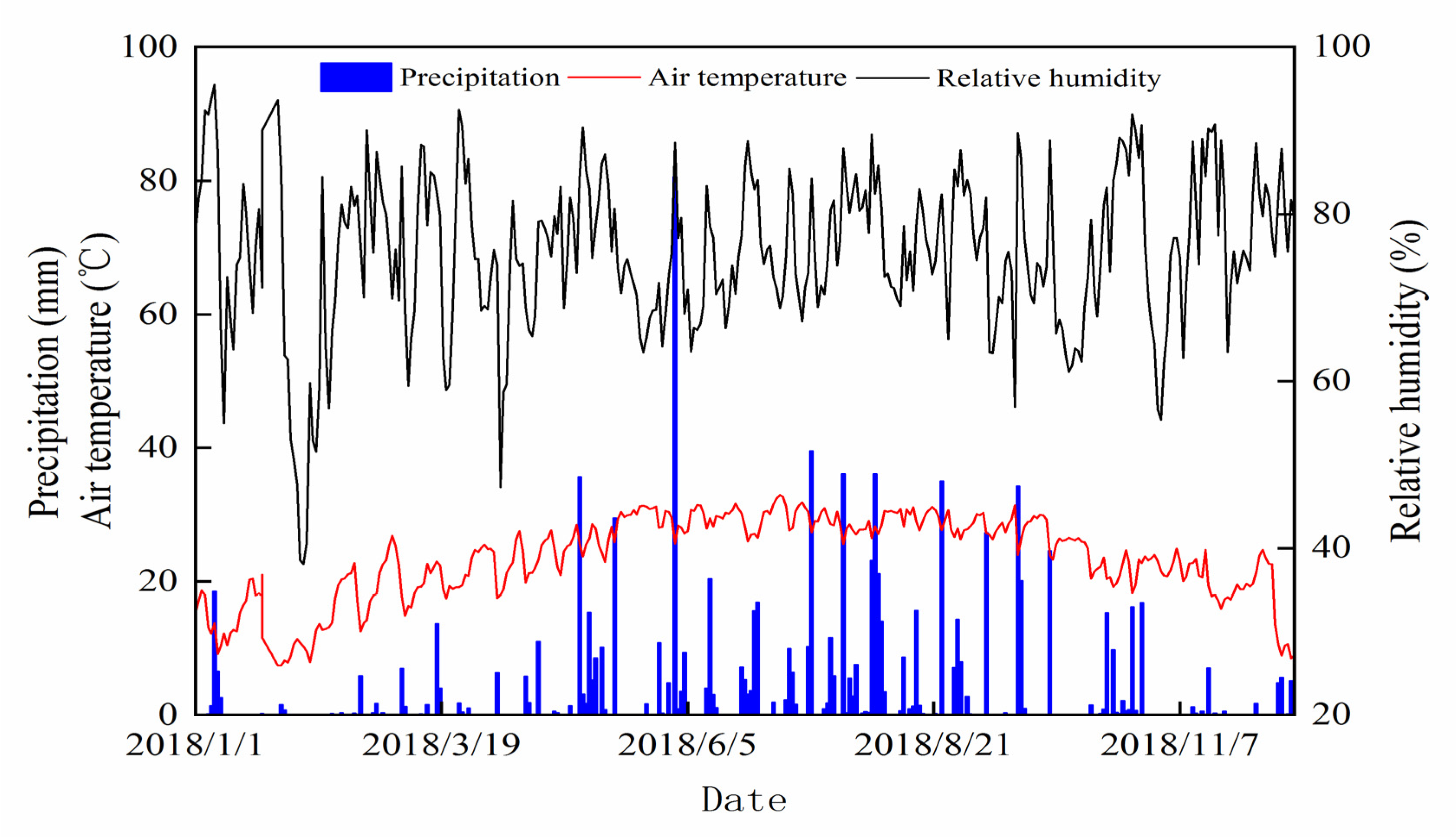
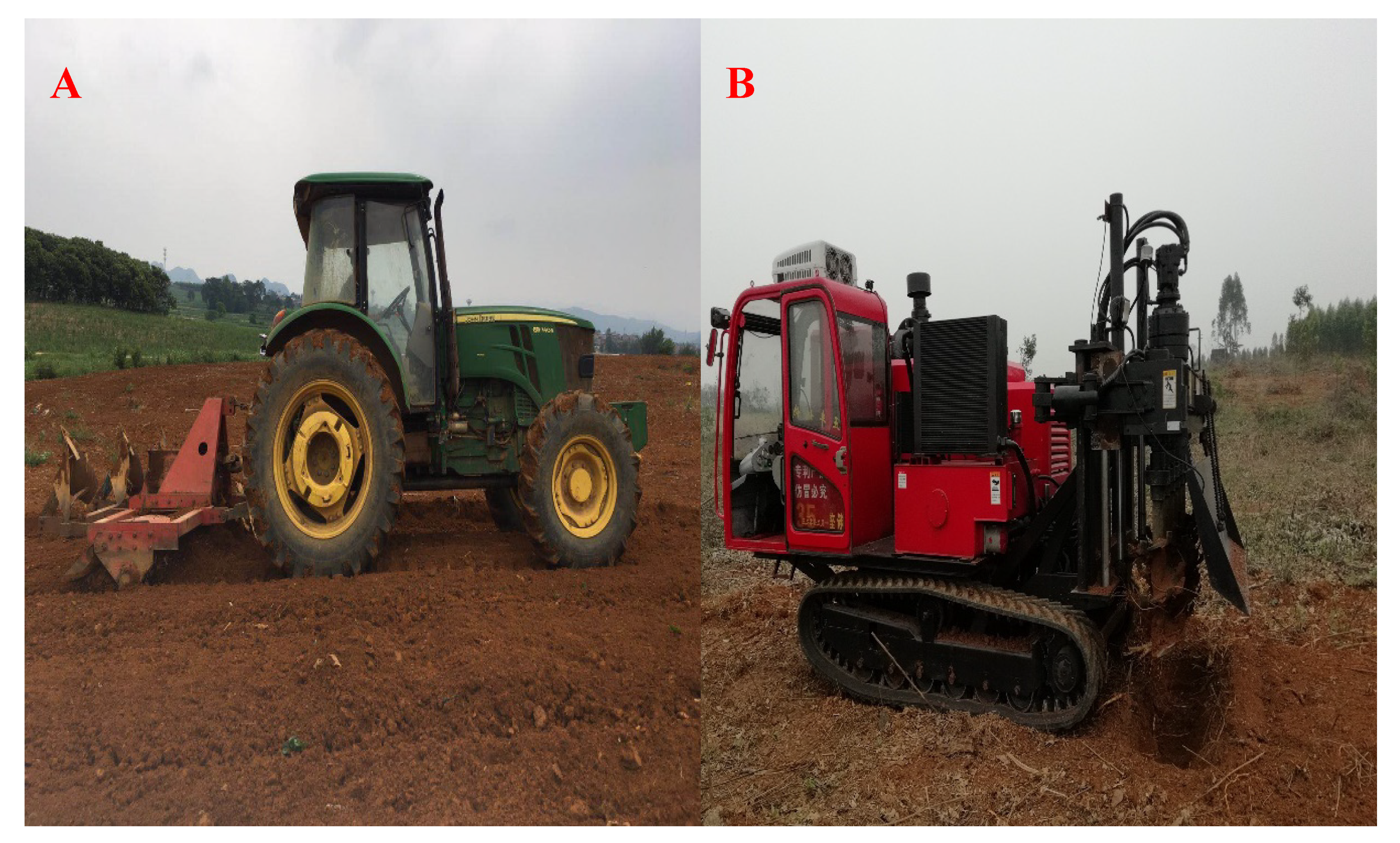
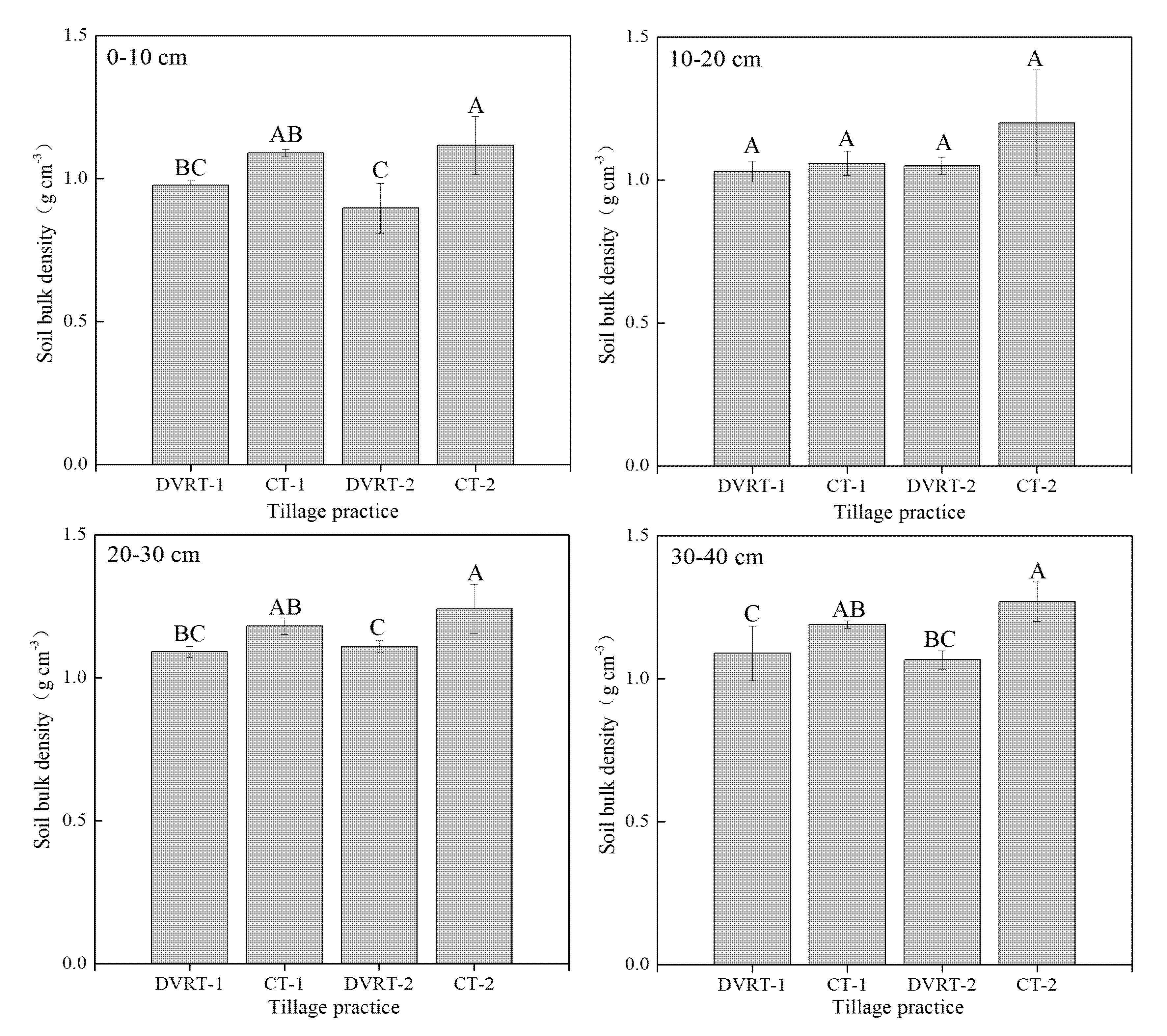
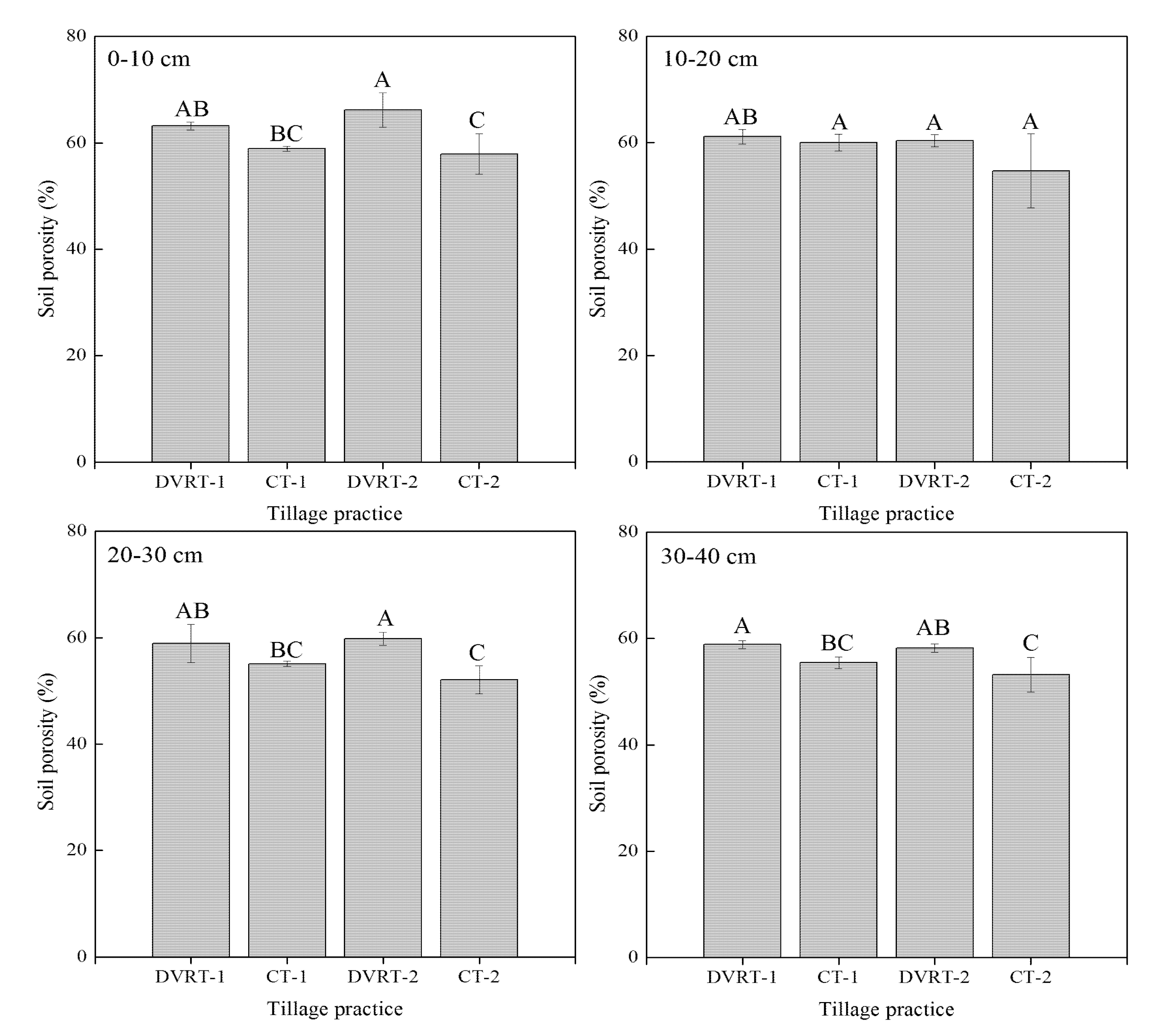
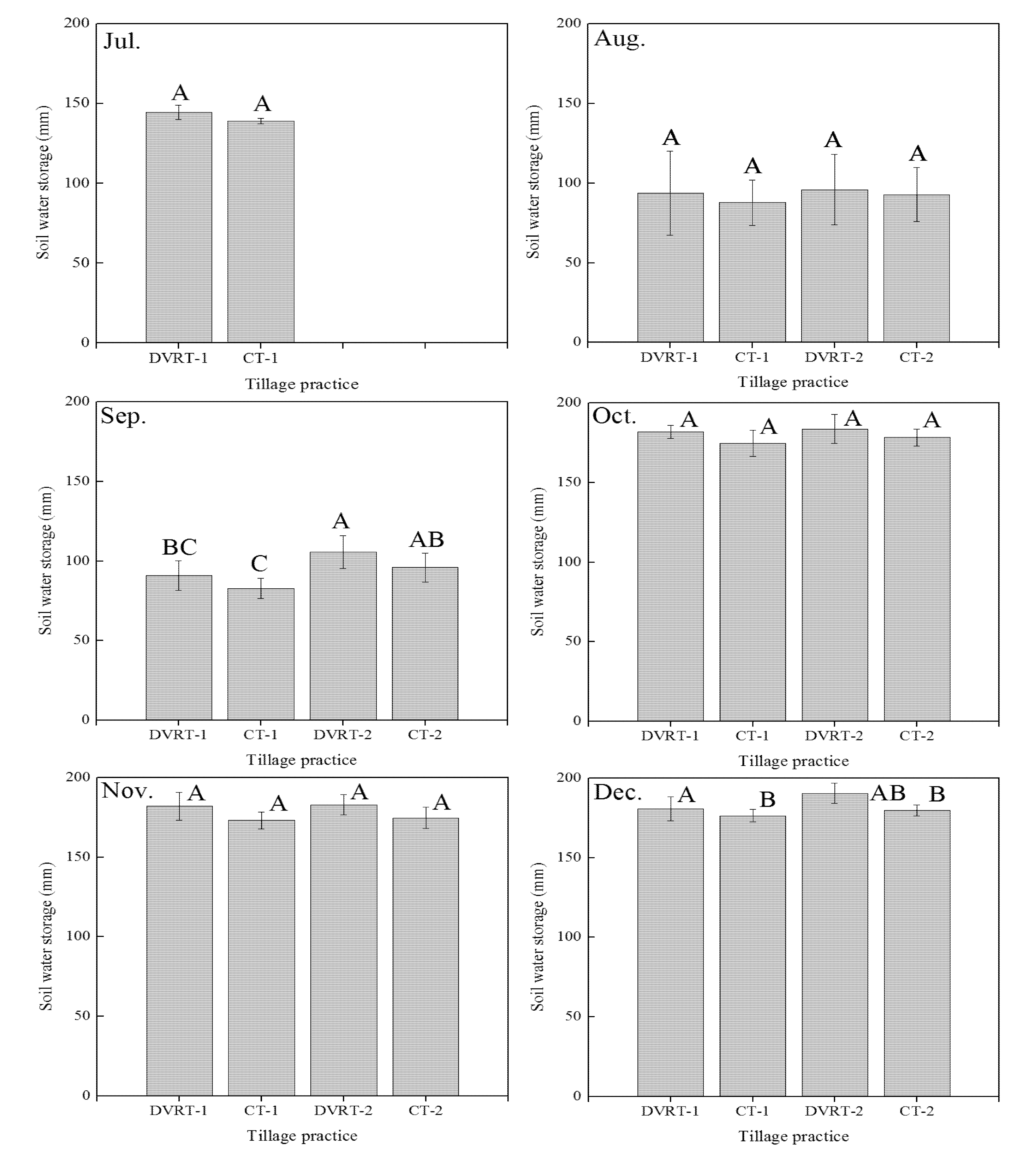
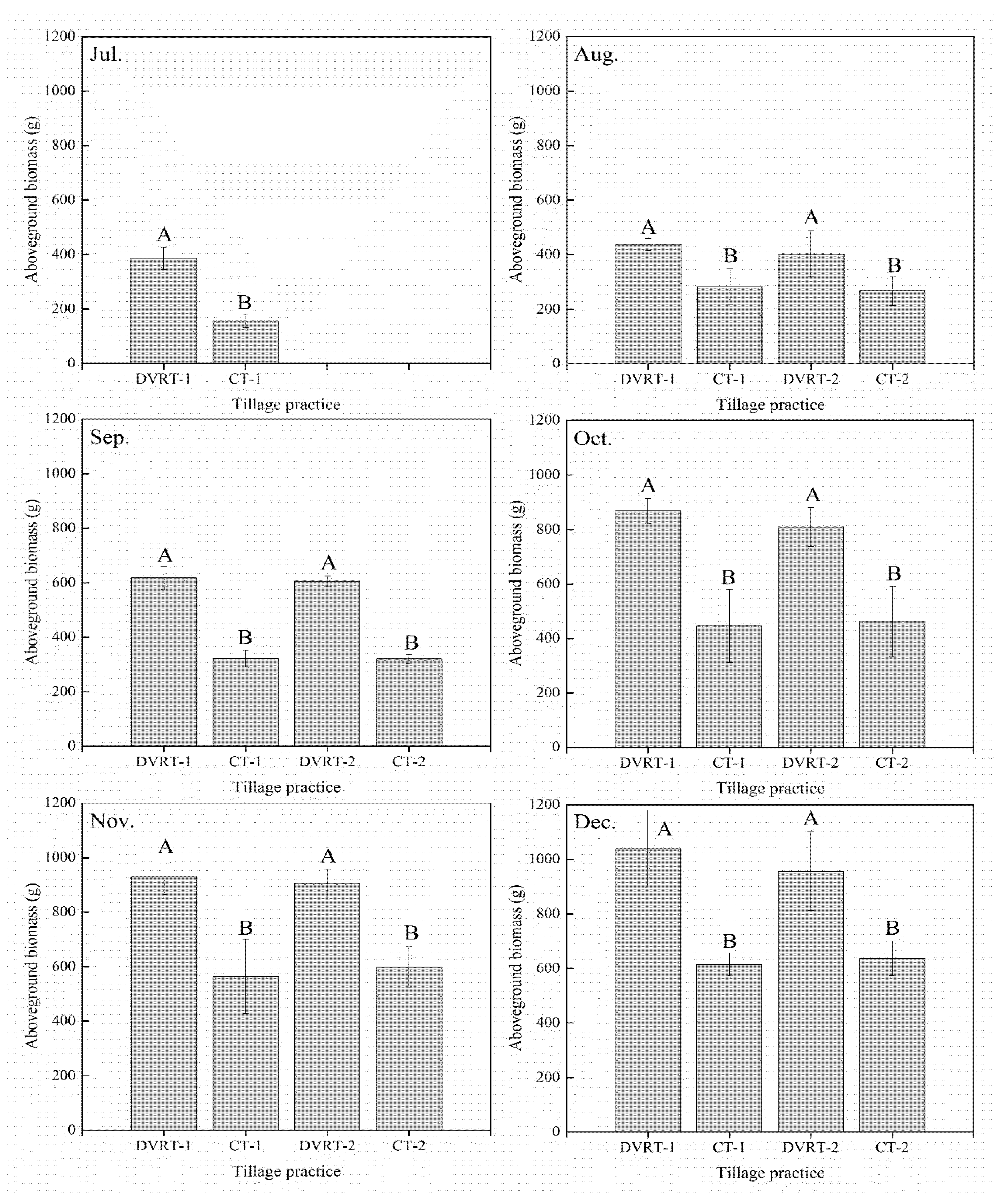

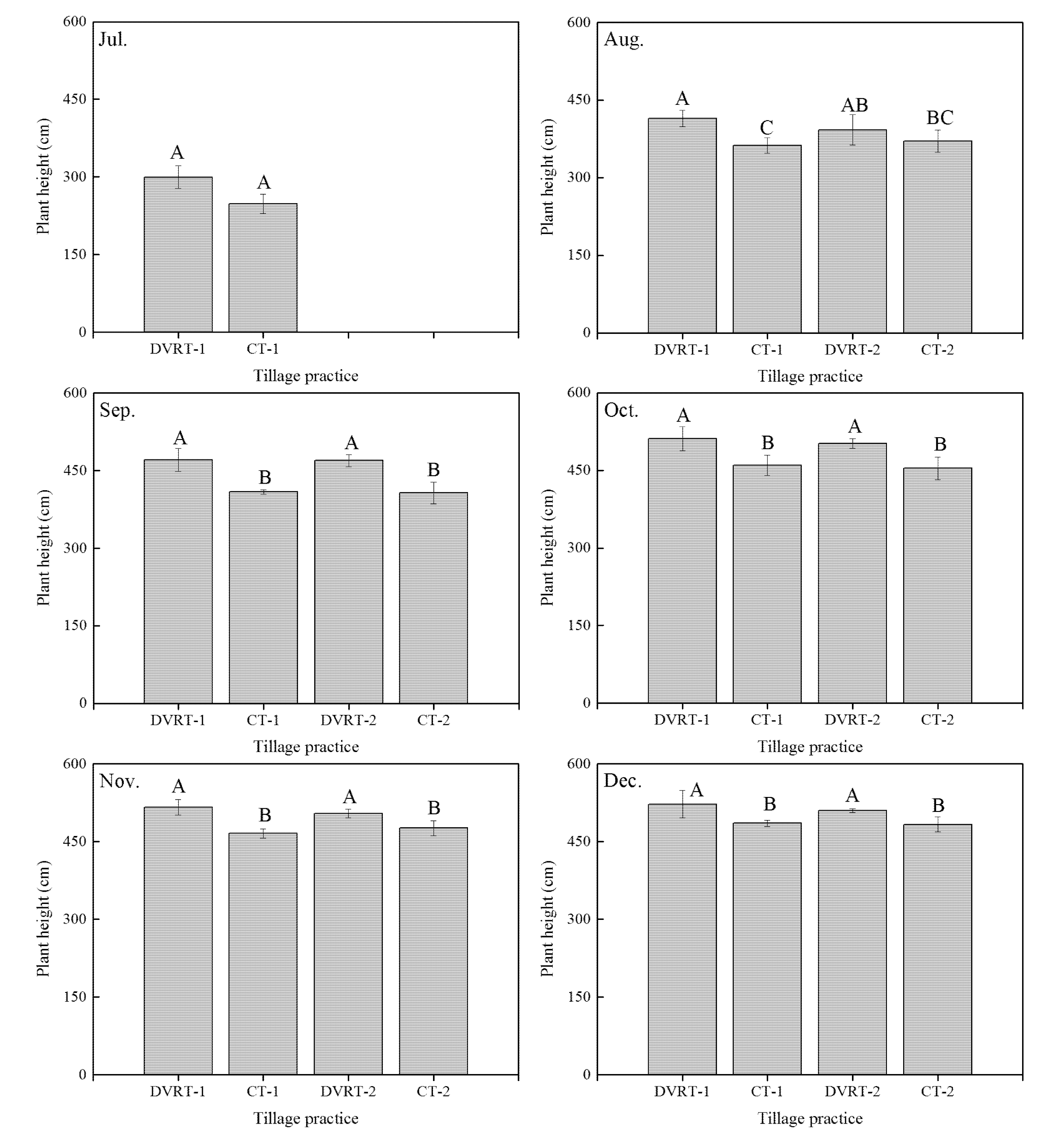
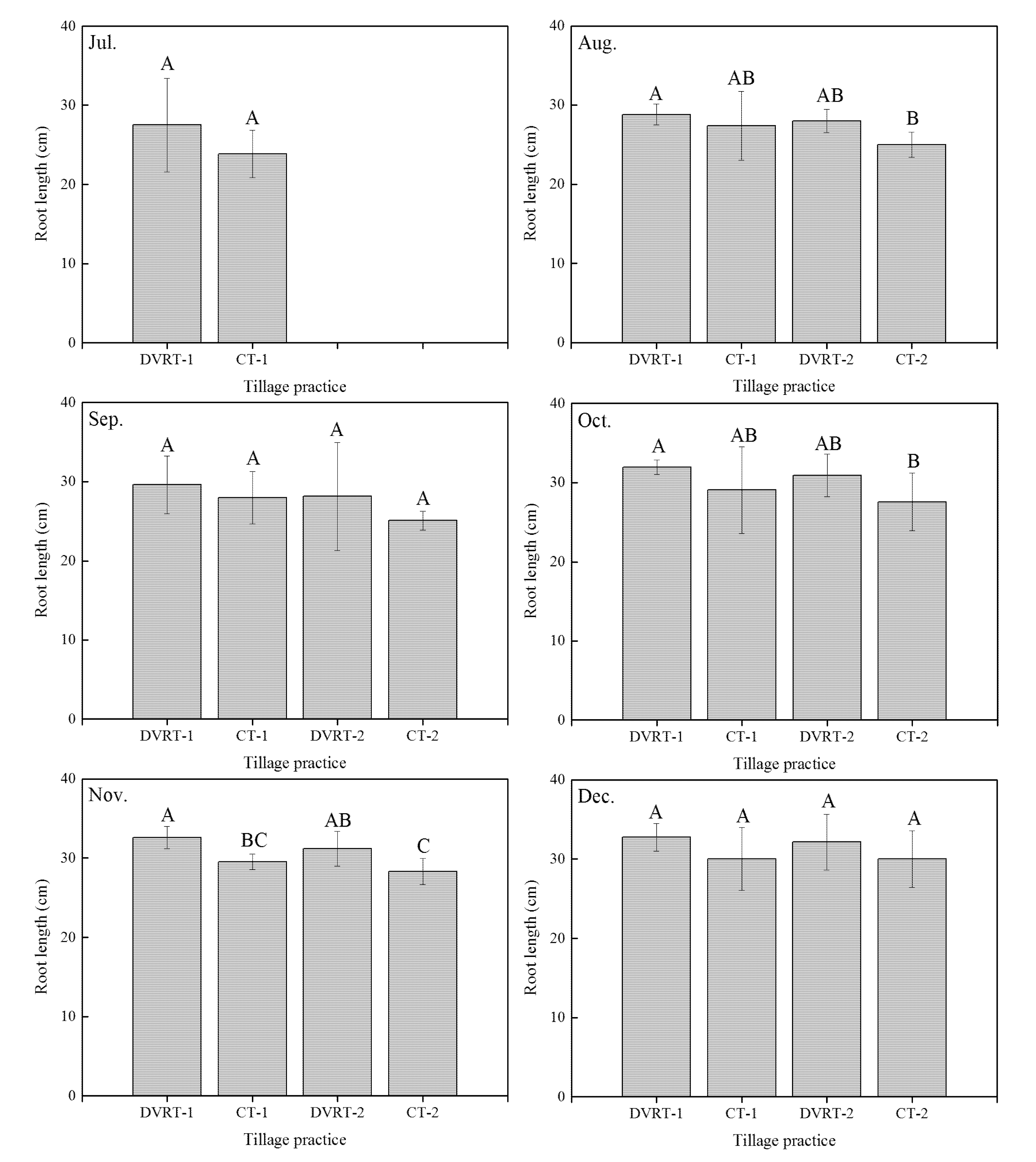
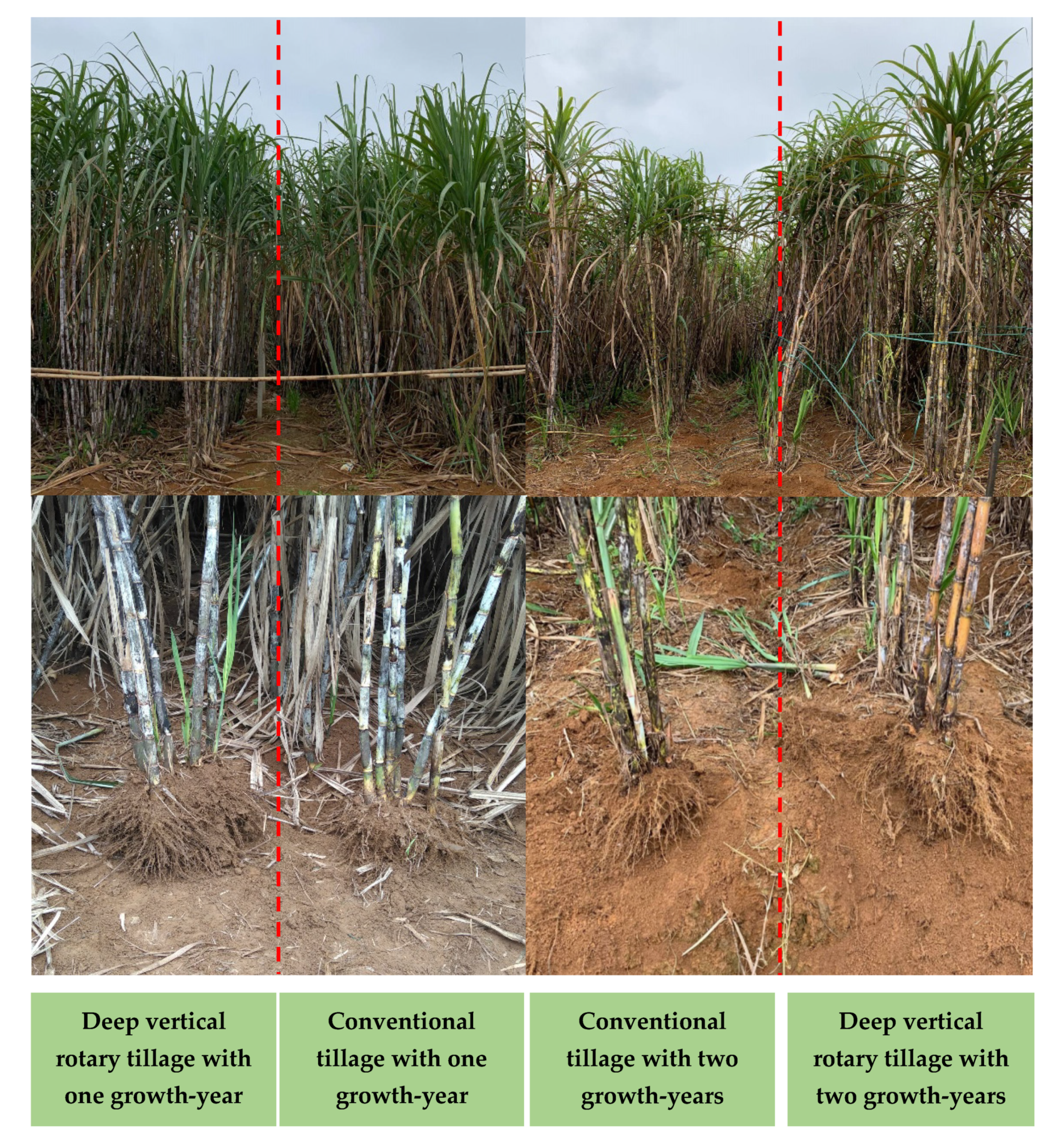
| Tillage Practice | SBD (g cm−3) | SP (%) | Clay (%) | Silt (%) | Sand (%) | SOC (g kg−1) | STN (g kg−1) |
|---|---|---|---|---|---|---|---|
| DVRT-1 | 0.98 ± 0.019 | 63.18 ± 0.72 | 21.46 ± 0.89 | 65.34 ± 1.53 | 13.21 ± 0.79 | 11.80 ± 0.87 | 3.11 ± 0.05 |
| CT-1 | 1.10 ± 0.013 | 58.88 ± 0.48 | 24.27 ± 1.12 | 63.59 ± 2.60 | 12.15 ± 2.34 | 10.42 ± 0.29 | 3.53 ± 0.10 |
| DVRT-2 | 0.90 ± 0.087 | 66.20 ± 3.27 | 24.24 ± 1.63 | 67.83 ± 1.58 | 7.94 ± 2.12 | 10.63 ± 0.54 | 2.97 ± 0.12 |
| CT-2 | 1.12 ± 0.101 | 57.91 ± 3.82 | 29.23 ± 0.84 | 56.56 ± 2.70 | 14.21 ± 3.53 | 12.06 ± 0.68 | 2.72 ± 0.07 |
| Treatment | Operation Procedure |
|---|---|
| CT | Conventional rotary tillage to 20 cm depth was performed by a rotavator → land leveling → planting trench (0.5 m wide and 0.3 m deep) was implemented with a tractor → the sugarcane setts were manually placed overlapping in the fertilizer-filled furrow and then covered with soil (the row spacing was 1.2 m) → no other tillage practice was performed in the later sugarcane growth period |
| DVRT | Deep vertical rotary tillage to 40 cm depth was performed by a newly-developed deep rotary tiller → land leveling → planting trench (0.5 m wide and 0.3 m deep) was implemented with a tractor → the sugarcane setts were manually placed overlapping in the fertilizer-filled furrow and then covered with soil (the row spacing was 1.2 m) → no other tillage practice was performed in the later sugarcane growth period |
| Increase Rate (%) | Variable | July | August | September | October | November | December |
|---|---|---|---|---|---|---|---|
| SWS (mm) | 3.97 | 6.93 | 9.88 | 4.04 | 5.13 | 2.47 | |
| AGB (g) | 146.84 | 54.39 | 92.50 | 94.71 | 64.84 | 68.90 | |
| DVRT-1/CT-1 | UGB (g) | 68.78 | 20.33 | 138.78 | 42.23 | 44.75 | 46.58 |
| PH (cm) | 20.83 | 14.47 | 15.03 | 11.24 | 10.84 | 7.55 | |
| RL (cm) | 15.38 | 5.26 | 5.84 | 9.89 | 10.27 | 9.11 | |
| SWS (mm) | -- a | 3.20 | 10.03 | 3.01 | 4.76 | 5.89 | |
| AGB (g) | -- | 50.77 | 89.25 | 74.94 | 51.50 | 50.14 | |
| DVRT-2/CT-2 | UGB (g) | -- | 44.05 | 117.48 | 101.55 | 79.05 | 69.67 |
| PH (cm) | -- | 5.80 | 15.27 | 10.54 | 5.88 | 5.51 | |
| RL (cm) | -- | 12.08 | 12.22 | 12.09 | 10.12 | 7.17 |
Publisher’s Note: MDPI stays neutral with regard to jurisdictional claims in published maps and institutional affiliations. |
© 2020 by the authors. Licensee MDPI, Basel, Switzerland. This article is an open access article distributed under the terms and conditions of the Creative Commons Attribution (CC BY) license (http://creativecommons.org/licenses/by/4.0/).
Share and Cite
Li, X.; Wei, B.; Xu, X.; Zhou, J. Effect of Deep Vertical Rotary Tillage on Soil Properties and Sugarcane Biomass in Rainfed Dry-Land Regions of Southern China. Sustainability 2020, 12, 10199. https://doi.org/10.3390/su122310199
Li X, Wei B, Xu X, Zhou J. Effect of Deep Vertical Rotary Tillage on Soil Properties and Sugarcane Biomass in Rainfed Dry-Land Regions of Southern China. Sustainability. 2020; 12(23):10199. https://doi.org/10.3390/su122310199
Chicago/Turabian StyleLi, Xuezhang, Benhui Wei, Xianli Xu, and Jia Zhou. 2020. "Effect of Deep Vertical Rotary Tillage on Soil Properties and Sugarcane Biomass in Rainfed Dry-Land Regions of Southern China" Sustainability 12, no. 23: 10199. https://doi.org/10.3390/su122310199
APA StyleLi, X., Wei, B., Xu, X., & Zhou, J. (2020). Effect of Deep Vertical Rotary Tillage on Soil Properties and Sugarcane Biomass in Rainfed Dry-Land Regions of Southern China. Sustainability, 12(23), 10199. https://doi.org/10.3390/su122310199






